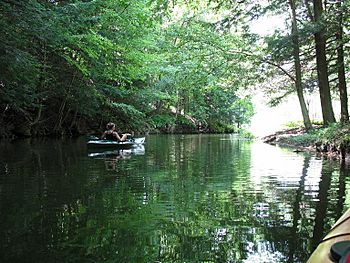Kennedy Creek (Pennsylvania) facts for kids
Quick facts for kids Kennedy Creek |
|
|---|---|

Kayakers on Kennedy Creek in
Lackawanna State Park |
|
| Physical characteristics | |
| Main source | Small wetland in Scott Township, Lackawanna County, Pennsylvania Between 1,460 and 1,480 feet (445 and 451 m) |
| River mouth | Lackawanna Lake on South Branch Tunkhannock Creek in North Abington Township, Lackawanna County, Pennsylvania, at Carpenter Town 984 ft (300 m) 41°34′00″N 75°42′17″W / 41.56654°N 75.70482°W |
| Length | 5.3 mi (8.5 km) |
| Basin features | |
| Progression | South Branch Tunkhannock Creek → Tunkhannock Creek → Susquehanna River → Chesapeake Bay |
| Basin size | 6.17 sq mi (16.0 km2) |
| Tributaries |
|
Kennedy Creek is a small stream, also called a tributary, located in Lackawanna County, Pennsylvania. It flows for about 5.3 miles (8.5 km) through Scott Township and North Abington Township. The area of land that drains into the creek, called its watershed, is about 6.17 square miles (16.0 km2).
Many bridges have been built over Kennedy Creek. The creek's watershed is a special place for fish. It is known as a Coldwater Fishery and a Migratory Fishery. The creek also flows through Lackawanna State Park, where you can find trails and go canoeing.
Contents
Exploring Kennedy Creek's Path
Kennedy Creek starts in a small wetland in Scott Township. It flows north for a short distance next to Pennsylvania Route 347. Then, it crosses Pennsylvania Route 632 and turns towards the north-northwest.
After a bit, it gets water from a small stream on its left side. The creek then turns north-northeast, flowing near Newton Hill and Weatherby Hill. It changes direction again, heading north-northwest and then west, crossing over Interstate 81.
The creek flows north for a short time before turning northwest. It crosses Pennsylvania Route 524 and enters North Abington Township. Here, it turns southwest, crossing Pennsylvania Route 524 again. After a short distance, it turns northwest and receives water from two more small streams.
Kennedy Creek then flows west-northwest for a few miles through a valley. It runs alongside Pennsylvania Route 524, passing Sarnoski Hill. In this area, two more unnamed streams join it from the right. The creek then turns west, passing Turkey Hill and getting another stream from the right.
Finally, the creek turns northwest for a short distance, crossing Pennsylvania Route 524 one last time. It then turns west and flows into Lackawanna Lake. This is where Kennedy Creek meets South Branch Tunkhannock Creek.
Water Quality in Kennedy Creek
The water in Kennedy Creek is generally clean. It is not listed as an "impaired waterbody," which means it meets water quality standards.
Scientists have tested the creek's water. In 2006, they found tiny amounts of a chemical called trichloroethylene near Interstate 81. However, later tests in the same year showed that the creek was free of this chemical and others like perchloroethylene.
Land and Rocks Around the Creek
The land around Kennedy Creek is interesting. The area where the creek flows into Lackawanna Lake is about 984 feet (300 meters) above sea level. The creek's starting point is much higher, between 1460 and 1480 feet (445 and 451 meters) above sea level.
Near the mouth of the creek, there's a very pretty ravine with hemlock trees. The ground along much of the creek is made of alluvium, which is soil deposited by flowing water.
The wider valley around the creek mostly has a type of soil called till, specifically Wisconsinan Till. This soil was left behind by glaciers long ago. Near the creek's mouth, you can also find bedrock made of sandstone and shale. Where the creek crosses Interstate 81, there's some fill material.
Kennedy Creek's Drainage Area
The watershed of Kennedy Creek covers an area of about 6.17 square miles (16.0 km2). This entire area is located within the Dalton quadrangle, which is a map section used by the United States Geological Survey. The creek's mouth is in a place called Carpenter Town.
Kennedy Creek is important for aquatic life. It is one of the main streams that drains water from Scott Township.
A Look at Kennedy Creek's Past
Kennedy Creek was officially added to the Geographic Names Information System on August 2, 1979. This system keeps track of place names in the United States.
Many bridges have been built over the creek over the years. For example, a steel bridge carrying Pennsylvania Route 347 was built in 1938 and fixed in 1955. Other bridges carrying Pennsylvania Route 524 were built in 1939 and 1986. A concrete bridge for State Route 4007 was built in 1962.
In 2015, students from Riverside High School helped test the water quality of Kennedy Creek. They performed chemical and biological tests to learn more about the creek's health.
Wildlife and Fish in the Creek
The watershed of Kennedy Creek is a special place for fish. It is known as a Coldwater Fishery and a Migratory Fishery. This means it's a good habitat for fish that prefer cold water, and also for fish that travel to different areas.
Wild trout naturally live and reproduce in Kennedy Creek. You can find them from the very beginning of the creek all the way to its mouth.
Fun Activities at Kennedy Creek
Kennedy Creek flows through Lackawanna State Park, which offers many chances for outdoor fun. In the park, you can go hunting on the right side of the creek.
Two multi-use trails in the park cross over Kennedy Creek. The creek's inlet at Lackawanna Lake is a great spot for paddling. Many people who enjoy canoeing love to spend time on Kennedy Creek.
The Countryside Conservancy helps protect some land along Kennedy Creek, upstream from Lackawanna State Park. This protected area, called the Hull Easement, covers about 124 acres (50 hectares).

